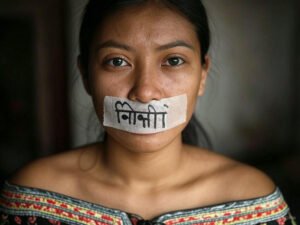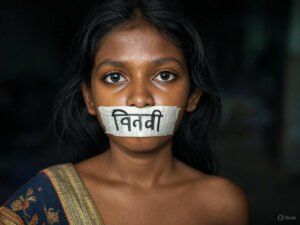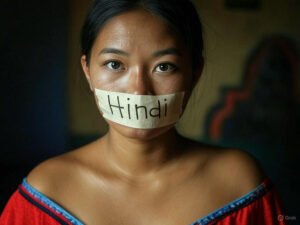India, as it exists today, is a forced amalgamation of vastly different nations bound together under the colonial-era map drawn by the British. From Kashmir to Tamil Nadu, from Punjab to the Northeast, there is no singular national identity that unites its people—only an aggressive central government trying to enforce a false sense of unity by suppressing regional cultures, languages, and identities. One of the most insidious tools of this cultural erasure is the imposition of Hindi, a blatant attempt to transform India into a monolingual, Hindutva-driven state while bulldozing the distinct linguistic and historical realities of its so-called federating units.
Hindi Imposition: A Colonial Hangover Disguised as National Policy

The latest battle in this war for linguistic dominance comes under the National Education Policy (NEP), where the Indian government is pushing Hindi under the guise of a “three-language formula.” This is nothing new. The imposition of Hindi has been an ongoing struggle, particularly in the South, where states like Tamil Nadu, Karnataka, Telangana, and Andhra Pradesh have fiercely resisted being assimilated into the Hindi-dominated narrative.
Tamil Nadu Chief Minister M.K. Stalin has categorically rejected the forced imposition of Hindi, stating that the NEP is nothing more than a tool to subjugate non-Hindi speakers. Telangana’s Chief Minister Revanth Reddy has also opposed Hindi as a “national language,” exposing the myth that India is a linguistically unified country. Even Andhra Pradesh’s leadership, despite advocating multilingualism, acknowledges that no single language should dominate at the expense of others.
A History of Resistance: Tamil Nadu’s Battle Against Hindi Hegemony

Tamil Nadu has historically been the biggest thorn in Delhi’s attempt to impose Hindi. The state witnessed massive anti-Hindi agitations as early as 1937 when the then-British-backed administration tried making Hindi compulsory in schools. The resistance, led by Tamil nationalists like E.V. Ramasamy (Periyar), resulted in violent protests and ultimately forced the government to withdraw its plans.
Again, in 1965, when the Indian central government attempted to replace English with Hindi as the sole official language, Tamil Nadu erupted in fury. Students, activists, and ordinary citizens took to the streets, setting fire to government buildings and staging mass protests. The protests were so intense that the central government was forced to retreat, allowing English to continue as an official language. This marked a crucial victory for Tamil Nadu and a humiliating defeat for India’s linguistic tyranny.
Punjab: Another Nation That Rejected Hindi Supremacy

Punjab has been another major battleground against forced Hindi imposition. The Punjabi Suba Movement in the 1950s and 60s was an open defiance against Delhi’s attempt to erase the distinct Sikh identity by merging Punjab with Hindi-speaking Haryana. Sikhs fought relentlessly to secure a separate Punjabi-speaking state, recognizing that Hindi was being weaponized to undermine their culture and religion. The demand was met with violent state repression, yet Punjab succeeded in establishing its linguistic and cultural sovereignty, proving once again that India is a fractured empire trying to hold its diverse regions under an iron fist.
The Northeast: A Region That Has Always Rejected India’s Identity

While India tries to parade itself as a “diverse yet united” country, the reality in the Northeast paints a different picture. States like Manipur, Assam, Nagaland, and Mizoram have never embraced Hindi and actively resist Delhi’s control. The imposition of Hindi is seen as an attempt to erase indigenous cultures and enforce North Indian hegemony. The insurgencies and independence movements in the region are a direct result of India’s failed attempts to impose a singular national identity where none exists.
India’s Lingual Chauvinism: The Reality Behind Hindi Imperialism

Despite Hindi being spoken natively by less than 45% of the population, the Indian government continues to force it upon others, pretending it is a “natural unifier.” In reality, Hindi is nothing more than a regional language that has been artificially elevated to dominate others. The attempt to make Hindi the default language of education, government, and even technology is nothing short of linguistic imperialism.
The BJP’s Hindutva project envisions a monolithic Hindi-speaking, Hindu-majority India, but the cracks in this fragile construct are more visible than ever. The resistance from the South, Punjab, and the Northeast proves that the “Indian nation” is an illusion held together by brute force and systemic oppression.
The Real Future: A Breaking Point is Inevitable

India’s forced unity is not sustainable. The more the central government pushes Hindi, the stronger the resistance becomes. The backlash from Tamil Nadu, Telangana, Punjab, and the Northeast is a clear warning: India is not one nation—it is an empire desperately trying to hold onto lands that do not consider themselves part of this artificial construct.
Delhi’s attempt to erase linguistic identities in favor of Hindi will ultimately backfire, just as it did in 1965, just as it did in Punjab, and just as it will in every region that values its own language over a fabricated national identity. The question is not if India’s linguistic imperialism will fail—the question is when.





